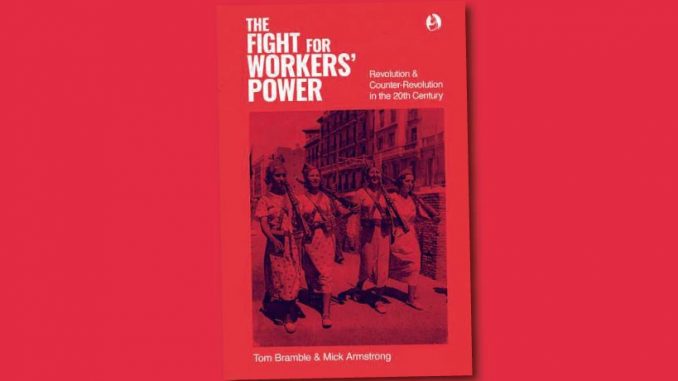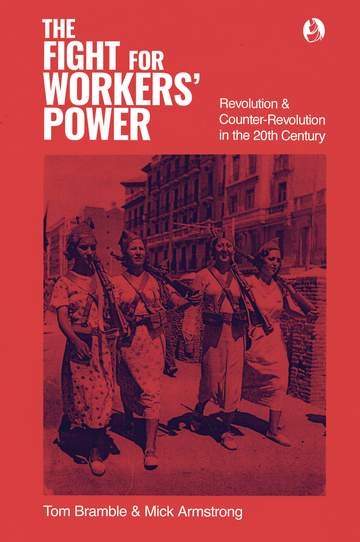
By: Luis Meiners
The book “The Fight for workers’ power: Revolution and counter-revolution in the 20th Century” by Tom Bramble and Mick Armstrong traces the history of class struggle in the recent past and provides important lessons for the present. The authors, both long-time socialist activists and founding members of Socialist Alternative, analyze history from a militant perspective without losing any analytical and historical rigor.
The scope of the work, both in historical and geographical terms, adds a particular interest to it. It analyzes events from 1914 to 1956, which take place around the world, from the Australian coal mines to the ports of the West Coast of the USA, passing through China, Russia, Eastern Europe, Greece, Italy, France, Spain, Germany and England. This provides an enormous amount of historical evidence that supports the main conclusions of the work.
A central element of the book, and one of its main contributions, is that it places the role of leaderships at the center of the analysis. It does so by focusing on revolutionary situations or situations of upsurge in which the class struggle becomes particularly acute, and also on defeats and counter-revolutions that made a mark on the 20th century. It examines the politics and orientations promoted by those who were at the head of the main organizations in each of these historical moments, and the impact these had on the course of events. In this sense, the importance of the fight for the leadership of the working class stands out.
Starting with the betrayal of reformism in the prologue to World War I, it reviews the major polemics that shaped the postwar revolutionary movement when revolutions broke out across much of Europe. From the triumph of the Bolsheviks to the German tragedy and the debates within the Third International, it goes through the dangers of opportunism and ultra-leftism. It points out the importance of international organization and of tactical flexibility and strategic clarity expressed in elements such as the “21 conditions” and the tactic of the United Front.

It then examines the Stalinist counterrevolution in the USSR, the degeneration of the International, and its impact on the high points of the class struggle such as the English general strike of 1926 and the Chinese revolution. With Stalinism’s increasingly firm grip on the Comintern and the Communist Parties, it approaches the turns of the “third period” and the Popular Front, and their often tragic consequences in Germany, Spain, Australia, France, and the United States. In the case of Spain, it also reviews the role of anarchism in a process in which this current had an important influence..
Finally it covers the role of Stalinism in deflecting the rise of anti-fascist resistance in Italy and Greece, the crushing of anti-bureaucratic revolts in Eastern Europe and the development of the Chinese revolution and the role of Maoism.
Beyond differences that one may have with some of the characterizations made by the authors throughout this historical journey, they make a great contribution through abundant evidence demonstrating the enormous revolutionary energy of the working class and the masses. This energy could have changed the course of history on more than one occasion during the 20th century. If it did not do so it was not because of its own limits, but because of the role of the reformist and counterrevolutionary leaderships and the absence of a revolutionary leadership that could meet the moment. As the authors point out:
“Blaming the masses for the failures of the leadership is a poor excuse, a means by which the role of revolutionary leadership is minimised and downplayed. Of course, there are whole historical periods where even the most far-seeing revolutionary leadership could have done absolutely nothing to drive forward the pace of events. But there are other periods when revolutionary leadership can make the decisive difference.” (p. 118)
In this sense, “The fight for workers’ power” brings fundamental lessons for those of us who remain committed to the fight against capitalist barbarism. In particular, the importance of the fight for the leadership of the working class and the need to build a revolutionary party rooted in its struggles, a militant organization built by committed cadres, as an indispensable tool for this task. For all these reasons, it is a work whose reading will undoubtedly be a valuable contribution to the formation of these cadres.
We live in a period of crisis and rebellion. Around the globe we have seen enormous displays of the fighting energy of the people. However, the reformists and defenders of “what is possible” insist on holding the masses responsible for the limits that their own political orientations impose on them. As revolutionaries we have the task of fighting against these visions. This book provides us with tools for that struggle.








